Myrtle Evelyn Squire: Teacher
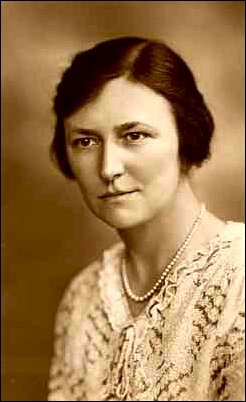
Myrtle Squire 1935. Courtesy Gwen Dennis.
My memory of Myrtle Squire was of a physically short woman with black hair tied back in a tight bun, wearing medium heeled lace up shoes. I was promoted to her class in 1943 from grade two along with other pupils from the class of Florence Burvill. While I was looking forward to writing in real books, receiving copies of the School Paper, and using pen and ink for the first time, there was an element of anxiety because Miss Squire had a reputation among the senior students at the school of being a strict disciplinarian.
I have no recollection of being strapped by her, a common form of punishment at the time, but I can remember early attempts at dictation and Miss Squire reading us stories in our wooden classroom, a ‘portable’ located at the rear of the main school building. My association with Miss Squire was brief, as along with many other Cheltenham residents I was struck down with typhoid during the epidemic of 1943, and by the time of my return to school from the Fairfield Infectious Diseases Hospital Miss Squire had left to take up a position at Dandenong State School. Nevertheless, many other students from Cheltenham, Mentone, Beaumaris, Mordialloc and other locations benefited from her teaching until 1963 when she retired from the Victorian Education Department.
Myrtle Evelyn Squire was born at Pyramid Hill on June 19, 1898, and attended Mologa State School in a ‘broken fashion’ up to third class before moving with the family on St Patrick’s Day, 1908, to Mentone. As she had not been able to go to school regularly much of her early education took place at home. She recounted the joy she experienced on opening for the first time her Royal Reader. “It came by post and I never ever will forget the lovely smell of a new book,” she recalled. [1]
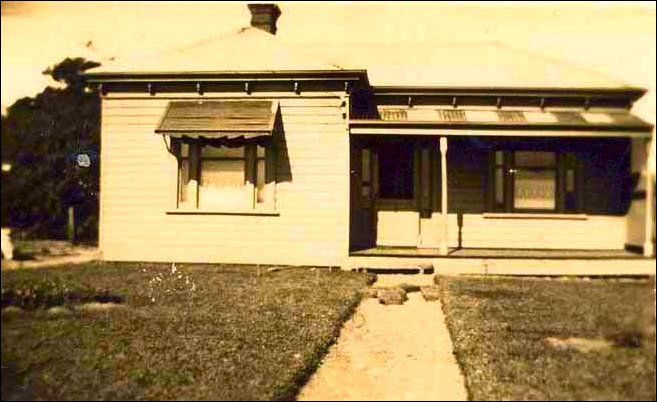
Squire family home ‘Colchester’ at Mentone, c1923. Courtesy Gwen Dennis.
After arrival in Mentone, Myrtle and her younger sisters, Olive and Lilian, resumed their schooling at the local State school which at that time was conducted as an annex to the Cheltenham school. After being tested in Arithmetic, Spelling and Composition to determine her standard of achievement, Myrtle was placed in Miss Tulloh’s class three, the equivalent to Fourth Grade, and there she stayed for the remainder of the year. Olive joined the first class and Lilian was placed in the second class, with Cyril joining them at the school the following year. Other children in the family, Hazel, Gordon and Bruce, joined them later.
Shortly after the arrival of the Squire family the Mentone school regained its full status and Thomas Townsend was appointed Head Teacher. Numbers at the school increased and additional staff were gradually appointed.

Mentone State School, 1910. Courtesy Mordialloc and District Historical Society.
Many years later Myrtle described the class arrangements at the school. “There was a thick beige curtain, (supplied at a cost of £2 and hung by the School Committee) on a long rod with several supports from the front of the room to the back wall. It was in two sections and could be pushed back so that the whole school could be opened up when Mr Townsend wanted the whole school to participate in special programs or celebrations. The lady teachers were in charge of the eastern end and he was in charge of the four top classes. …. In the senior section there were three little platforms. Front desks were on the floor, one step up was the next row, another step up was the next row, and the seniors sat at the top, and each one was wide enough to accommodate the desk – long desks where everybody’s stuff was put underneath and got mixed up and there were often arguments about ‘He’s got my stuff’. Eventually, we got two-seater desks and we got a part each and that was a great step up.” [2]
Myrtle remembered the ‘egg days’ while a student at Mentone State School. Children would collect eggs from parents and friends for distribution to local hospitals. From Mentone, she said, they would walk to the Benevolent Asylum on the corner of Warrigal and Heatherton roads in Cheltenham, carrying the eggs in baskets. Amazingly, during the long walk, the eggs were not broken was her comment. [3] This practice of school children collecting eggs for hospitals was one that continued during Myrtle’s teaching career, often with grades competing with one another to see who could collect the most..
Reflecting on the curriculum of her student and early teaching days and comparing it to the 1960s Myrtle despaired. Parsing had gone out of fashion. “When we had parsing, we understood better how to construct language and expression ourselves … in arithmetic we learned just by doing it and doing it and doing it until it dawned on us why were doing it. Time and work, ratio and proportion, long division. [4] Oh! Some youngsters used to find it an awful job – but we came to understand why we did it by doing it. It wasn’t just theory to us.” [5]
By 1912 Myrtle had qualified for her Merit Certificate, a major achievement at that time, but she had to wait for the local District Inspector to conduct an oral test, listen to her read, and check other aspects of her work before the certificate could be confirmed. In the meantime Myrtle became a monitor in the school, teaching the ‘littleuns’ and helping older students who had missed school due to illness. This was great experience for her because she wanted to attend Melbourne High School and become a teacher.
At the end of 1913 Myrtle left the Mentone school to continue her education at Melbourne High School where she studied for two years to qualify for the Junior Public Examination, a requirement for those wishing to join the public service or wanting to become teachers. On February 6, 1916, she was appointed to Cheltenham State School as a Junior Teacher, Class 3, on Probation and remained at that school until transferring to a school back in the mountains of Tallangatta. Her initial inspectors saw her as having the makings of a good teacher, a person who gave a good lesson but believed, in what was an early stage of her career, an unbending and at times a harsh manner although reports from the school indicated she was improving in this regard.[6]
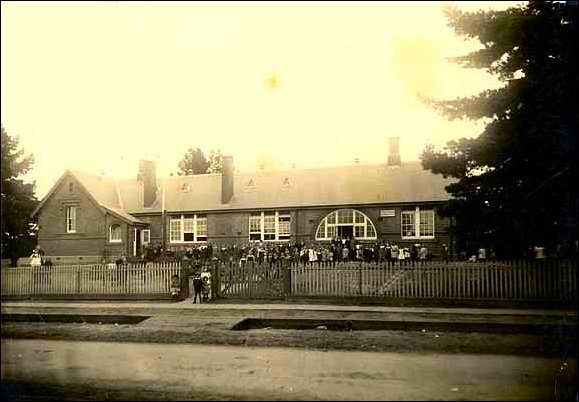
Cheltenham State School No 84, c1916. Courtesy Gwen Dennis.
Myrtle believed she received an excellent grounding in teaching at the Cheltenham school because she had a ‘roving commission’ around the school, teaching in all grades. There was also a time when she assisted the Head Teacher take grades 7 and 8 because he could not be in the room all the time. “The junior teacher who was with him had disciplinary problems so he transferred me there to help out,” she said. [7]
On May 13, 1920 she took up her appointment to Upper Sandy Creek School, No 3145. The school, consisting of a wooden room 25 feet by 15 feet with hessian-lined walls was erected in 1891. [8] When Myrtle Squire arrived there were twelve pupils attending the school ranging from the beginners class to grade eight. After travelling by train from Spencer Street to Wodonga she was met by a retired school master who was a friend of Myrtle’s minister at Cheltenham. After “a lovely hot meal, Irish Stew” she caught the train to Huon where she was met by Mr Nisbett who informed her she would be boarding with his family until other accommodation could be arranged. Mr Nisbett explained the previous teacher had boarded with a Catholic family but they preferred not to take a Protestant into their household. Word had spread from Cheltenham to the Upper Sandy Creek district through a woman, who originally lived in Cheltenham but who had married a local resident, of Myrtle’s association with the Methodist Church. Myrtle’s comment was ,”Like all country districts, news and gossip travelled quickly and swiftly and very often inaccurately.” [9]
After being met at the station, loading her tin trunk, and climbing into the buggy with the tall Mr Nisbett and a youth, they set off in the dark on a wet road because the rain had been pretty prolific, recalled Myrtle. “Shortly after the horses became restive. Mr Nisbett put the reins in my hand and said hold them firmly but not tight. So he jumped out and the boy jumped out. They went to the head of the horses and calmed them down. It was dark except for the lights on the trap but the situation was quickly appreciated. A tree had fallen across the road. Very gently the horses were led down off a bit of a rise and we got around on the other side and after settling them down a bit we got going again.” [10] A few miles further on the party arrived at the track leading to the house where Mrs Nisbett was waiting with lantern in hand to warmly greet the new ‘schoolie’ and provide her with “a lovely hot meal before retiring early to bed.”
The next day Myrtle Squire accompanied by Mr Nisbett went to the school to meet her new charges. “They looked me up and down and the man prior to me had been a tall well built man and here I was, five feet and a quarter of an inch. … we went in and got ourselves sorted out. I got hold of the roll and opened to find out who the children were and identified them. Fred O’Hanson asked me ‘How did you get here Miss Squire?’ I said it’s a long story and would tell it to them at dinner time. It is school time now we have to start some work.”
Miss Squire recounted the time at Upper Sandy Creek when two creeks, normally dry, had filled up after heavy rain making access to the school difficult. “Mr Nesbitt saddled up Jenny the pony for me. I said I didn’t know anything about riding. He said walk her and she will do all the rest. She did. We got to this wide pool. Jenny splashed into the middle of it and stood stock still. No amount of persuasion or a slap on the neck would shift her. The youngsters over in the school ground were laughing their heads off. Coming towards me on the road on the side of the creek was the father of one of the families. He also joined in the roar of laughter. ‘Up to her old tricks is she?’ He walked his horse in, turned around and Jenny walked out like a lady. I didn’t have to unsaddle or unbridle the horse or get its feed ready. The boys did that for me. They did the same at night when it came time to be getting home.” [11]
After six months at Upper Sandy Creek Myrtle applied for a transfer. Normally transfers were only granted after two years service in a school, but Myrtle’s mother was seriously ill with cancer and not expected to live beyond a few months. Granted a compassionate transfer Myrtle was fortunate to gain a Junior Teacher, First Class vacancy at the Cheltenham State School from the beginning of 1921. As she said, “Back to the old school.” [12]
On April 12, 1926 Squire received promotion at Cheltenham to the classification of a Class V Assistant. Her inspector’s report, submitted several months later indicated that her management was strong although he believed her manner could be a little more sympathetic. Her lessons were impressively presented and she displayed initiative and resourcefulness in her work. [13] During this period of seventeen years at Cheltenham successive inspectors’ reports referred to her energy and sincerity, sound teaching, good standards, thoroughness and good results. In May 1943 she took a promotion as a Class IV Assistant to the Dandenong State School where she remained for twelve months before returning to Cheltenham.
Although happy at Dandenong , Myrtle had to adjust her position because the school and her position at Dandenong had been reclassified and this called for someone with higher seniority than she held. Myrtle explained that the Education Department gave her a list of three or four schools where she could be placed. The first school on the list was Cheltenham and she decided, “to return home again.”
While at Cheltenham Myrtle applied for promotion to Heatherton State School but a woman two below her on the Teachers’ Classified Roll was given the position in error. As a result Myrtle was promoted to Assistant Class III and advised to remain at Cheltenham in a temporary position until a suitable vacancy could be found. The subsequent appointment to Mordialloc was followed by a promotion in 1951 to Moorabbin State School, Worthing Road, as Assistant Class II. Her inspector’s reports at this stage describe her as an experienced and very thorough teacher systematic and very conscientious in planning and preparation; one who teaches very successfully and promotes enthusiastic co-operation. Six years later, with a promotion to Class I, Myrtle was appointed to Beaumaris State School as the Infant Mistress, the senior woman in the school. There Myrtle was successfully managing a large infant department, where she believed she would see out her professional career. This was not to be as the number of pupils attending the school substantially increased and under Education Department rules the school was reclassified at a higher level, demanding a head teacher and infant mistress of a higher classification. Myrtle Squire and the head teacher had to adjust their positions by applying for positions at vacant schools at their respective levels of seniority. Myrtle took up the position of Infant Mistress at Sandringham East School from 1959 to 1963 when she retired from the Department. Her final inspector’s report read, “A very fine teacher who has served faithfully over the years. She retires from an Infant Department that is organized on splendid lines.” As a Woman Assistant Class I she was assessed as ‘Outstanding”. [14]
Running along side her professional career, Myrtle had another interest where she applied her teaching skills. This was her local church. When the Squire family first moved to Mentone and eventually took up residence at 108 Charman Road they became involved with the small brick Methodist Church close to the corner of Charman and Weatherall roads. “There was a vacant block beside it where the church people parked, it was the saddling up paddock. The church itself, built by the Rose brothers, was small,” recalled Myrtle. [15] “Just a few years after our arrival, the population of the district was growing and there wasn’t much room for Sunday School work in the little church, so it was decided to have a wooden addition. … We were able to have Sunday School in the new part, part of which was occupied by the very little ones, the first introduction to kindergarten and there was room for another junior class. A thick red baize curtain divided the church proper from the new building and the rest of the Sunday School met in the Church.”
When Myrtle Squire started as a Junior Teacher she was invited to help in the Methodist Sunday School. The person in charge of the kindergarten had decided to retire so Myrtle was asked to take charge. This she did until she moved to Upper Sandy Creek. On her return to Cheltenham she resumed her teaching in the Sunday School and continued in this role when the church moved to its new site and building in Charman Road, between Park and Point Nepean roads.
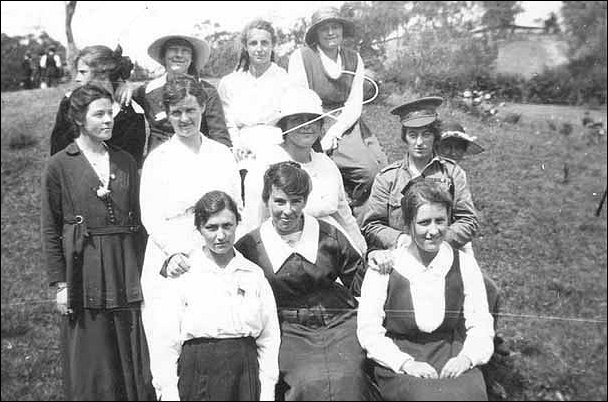
Members of the Cheltenham Methodist Church Youth Club – Bertha Woff, Ruby Tilley and Ella Allnutt. Front Row – Myrtle and Olive Squire. Courtesy Moorabbin and District Historical Society.
In addition to her teaching role, Myrtle took up several other positions in the church. She was an active member of the church choir from 1916 and maintained this connection in one capacity or another until 1986. When asked to name her favourite hymn she replied, “God is a spirit and they that worship him must worship him in spirit and in truth.” [16] She also worked for the Young Women’s Missionary Movement at the church from 1955, and earlier was circuit secretary for overseas missions making for a very strong commitment to the work of her church beyond the local parish. [17]
During the First World War Myrtle used to write to all the Sunday School boys who went to war and recalled the horrifying situation of the Second World War that many of the ‘little fellows you had had sitting in desks in front of you were fighting overseas.” [18] When World War One commenced Myrtle was a student at Melbourne High School and saw some of the senior boys, after becoming qualified by age, joining the military forces. She recalled, “a common practice in primary and high schools was for girls to knit socks, mufflers and what they used to call balaclava helmets that the men could pull over their heads and leave only slits for the eyes and noses. Kit bags were also sown. … Everything that the girls or boys took part in making included their name and the name of the school.” Myrtle’s sister, Lilian, got a letter from Ted Fisher a local boy, who was in Egypt. He wrote to say he was delighted to find her name in a new kit bag that had been issued to him and to know that it came from the Mentone School.
Myrtle Squire, living through the two Great Wars and several other international conflicts, held firm views about the nature of war and Australia’s involvement and relationship to Britain. She said, “War is the worst that can happen to a nation. … There is a lot of criticism now about the part Australia was called upon to play in both world wars. They are speaking with hind-sight. They didn’t live through the experiences the people had then. They didn’t live so close to the old Mother Land as we did. … Now there is all sorts of criticism being hurled at Britain and what she did or should have done and didn’t do. No country in the world has done so much for the world as the English speaking Britishers.” [19]
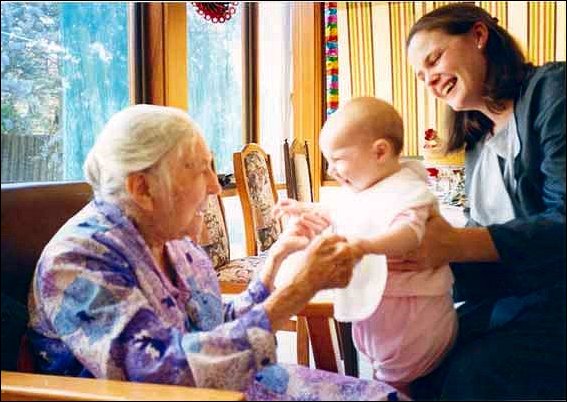
Myrtle Squire with great grand-niece Lilly and her mother Sue Dennis. Courtesy Gwen Dennis.
In 1995 Myrtle Squire moved into special accommodation at Nirvana in East Malvern after a stay at Como Hospital in Parkdale. While not well enough to return to her home in Collins Street, Mentone, and although blind, she joined in all the activities provided at her new home where she was particularly welcomed as a competitor in the quizzes because of her excellent memory. She listened to cricket and football on 3L0, using headphones, and a radio where the control had been taped so as to prevent it accidentally losing the station. Gwen Dennis, her niece, said Myrtle loved the cricket, having attended tests held in Melbourne as a young woman. She knew all the cricketers. Football was an interest that developed later in life but she was always interested in people. [20]
It was at Nirvana that she died on July 22, 1998, from a stoke at 100 years of age. She had a long life during which she had a significant impact upon the lives of many children through her work as a teacher and member of the local church.
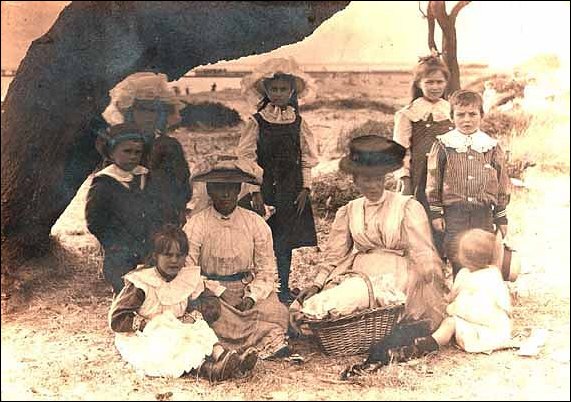
Squire family at Mordialloc Beach 1909. Standing – Gordon, Olive, Myrtle, Lilian and Cyril. Front – Hazel, Mrs Squire, Cousin Elizabeth and Bruce. Courtesy Gwen Dennis.
Footnotes
- Robinson, C., Additions & Subtractions: Mentone State School, No 2950, 1989, page 20.
- Robinson, C., Ibid, page 21.
- Whitehead, G., Interview with Gwen Dennis, 2003.
- Parsing was where sentences were broken up into their component parts – nouns, pronouns, adjectives, adverbs, infinitives, and conjunctions.
- Robinson, C., Op Cit. page 22.
- Education Department – Inspector’s Report.
- Ferguson, L., Interview with Myrtle Squire, 1988.
- Blake, L., Vision and Realisation, 1973 Volume 3 page 999.
- McCrae, Rev Richard, Interview with Myrtle Squire, c1995.
- McCrae, Ibid.
- McCrae, Ibid.
- McCrae, Ibid.
- Education Department, Inspector’s Report.
- Education Department, Ibid.
- McCrae, Op Cit.
- McCrae, Ibid.
- Moorabbin Standard News February 23, 1966.
- McCrae, Op Cit.
- McCrae, Ibid.
- Whitehead, G., Interview with Gwen Dennis, 2003.
